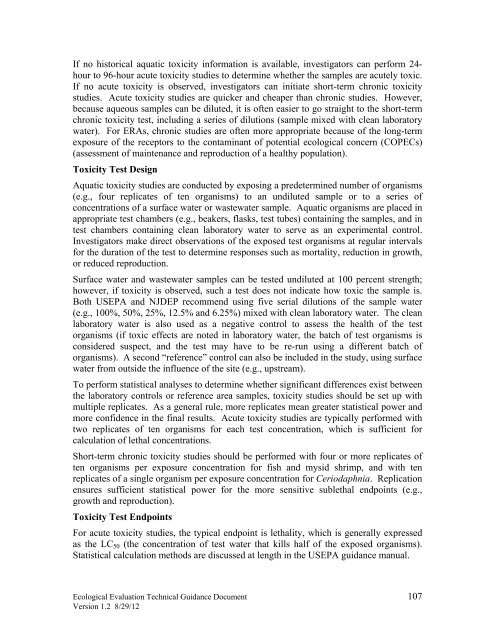Ecological Evaluation Technical Guidance - State of New Jersey
Ecological Evaluation Technical Guidance - State of New Jersey
Ecological Evaluation Technical Guidance - State of New Jersey
- No tags were found...
Create successful ePaper yourself
Turn your PDF publications into a flip-book with our unique Google optimized e-Paper software.
If no historical aquatic toxicity information is available, investigators can perform 24-hour to 96-hour acute toxicity studies to determine whether the samples are acutely toxic.If no acute toxicity is observed, investigators can initiate short-term chronic toxicitystudies. Acute toxicity studies are quicker and cheaper than chronic studies. However,because aqueous samples can be diluted, it is <strong>of</strong>ten easier to go straight to the short-termchronic toxicity test, including a series <strong>of</strong> dilutions (sample mixed with clean laboratorywater). For ERAs, chronic studies are <strong>of</strong>ten more appropriate because <strong>of</strong> the long-termexposure <strong>of</strong> the receptors to the contaminant <strong>of</strong> potential ecological concern (COPECs)(assessment <strong>of</strong> maintenance and reproduction <strong>of</strong> a healthy population).Toxicity Test DesignAquatic toxicity studies are conducted by exposing a predetermined number <strong>of</strong> organisms(e.g., four replicates <strong>of</strong> ten organisms) to an undiluted sample or to a series <strong>of</strong>concentrations <strong>of</strong> a surface water or wastewater sample. Aquatic organisms are placed inappropriate test chambers (e.g., beakers, flasks, test tubes) containing the samples, and intest chambers containing clean laboratory water to serve as an experimental control.Investigators make direct observations <strong>of</strong> the exposed test organisms at regular intervalsfor the duration <strong>of</strong> the test to determine responses such as mortality, reduction in growth,or reduced reproduction.Surface water and wastewater samples can be tested undiluted at 100 percent strength;however, if toxicity is observed, such a test does not indicate how toxic the sample is.Both USEPA and NJDEP recommend using five serial dilutions <strong>of</strong> the sample water(e.g., 100%, 50%, 25%, 12.5% and 6.25%) mixed with clean laboratory water. The cleanlaboratory water is also used as a negative control to assess the health <strong>of</strong> the testorganisms (if toxic effects are noted in laboratory water, the batch <strong>of</strong> test organisms isconsidered suspect, and the test may have to be re-run using a different batch <strong>of</strong>organisms). A second “reference” control can also be included in the study, using surfacewater from outside the influence <strong>of</strong> the site (e.g., upstream).To perform statistical analyses to determine whether significant differences exist betweenthe laboratory controls or reference area samples, toxicity studies should be set up withmultiple replicates. As a general rule, more replicates mean greater statistical power andmore confidence in the final results. Acute toxicity studies are typically performed withtwo replicates <strong>of</strong> ten organisms for each test concentration, which is sufficient forcalculation <strong>of</strong> lethal concentrations.Short-term chronic toxicity studies should be performed with four or more replicates <strong>of</strong>ten organisms per exposure concentration for fish and mysid shrimp, and with tenreplicates <strong>of</strong> a single organism per exposure concentration for Ceriodaphnia. Replicationensures sufficient statistical power for the more sensitive sublethal endpoints (e.g.,growth and reproduction).Toxicity Test EndpointsFor acute toxicity studies, the typical endpoint is lethality, which is generally expressedas the LC 50 (the concentration <strong>of</strong> test water that kills half <strong>of</strong> the exposed organisms).Statistical calculation methods are discussed at length in the USEPA guidance manual.<strong>Ecological</strong> <strong>Evaluation</strong> <strong>Technical</strong> <strong>Guidance</strong> Document 107Version 1.2 8/29/12
















